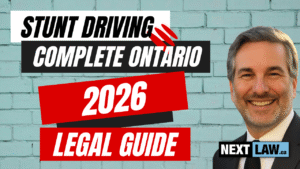
Stunt Driving Ontario: Complete 2026 Legal Guide
Stunt Driving Ontario: Complete 2026 Legal Guide Stunt driving charges in Ontario have reached unprecedented levels in 2025, with legal representative Jon Cohen documenting a


Explore the essentials of stunt driving charges under Ontario’s Highway Traffic Act in our in-depth guide. Dive into the legal definitions and ramifications of stunt driving, ensuring you’re informed and prepared.
Stunt driving or “street racing” in Ontario is any of eight risky acts—from 50 km/h + speeding to burn-outs and wheelies—prosecuted under Highway Traffic Act s.172(1).
Since July 2021, police may also lay the charge for 40 km/h over on roads posted 80 km/h or lower. First-timer or not, the law treats every stunt-driving stop as a public-safety hazard.
🔎 Tip: Try our free Stunt Penalty Calculator to see your exact fine and suspension risk in 30 sec.
Understand the law. To know how to fight a Stunt Driving charge in Ontario or a Racing charge, it’s important to understand the law that you have been charged under.
Ontario’s stunt driving, characterized by reckless actions such as excessive speeding, street racing, and other perilous driving activities, is a dangerous habit that threatens the safety of all road users. This behaviour, considered a severe violation even for a first-time offender, includes not only speed-related actions but also the implementation of unauthorized car modifications aimed at enhancing vehicle performance.
What speed is considered Stunt Driving (or Racing) in Ontario?
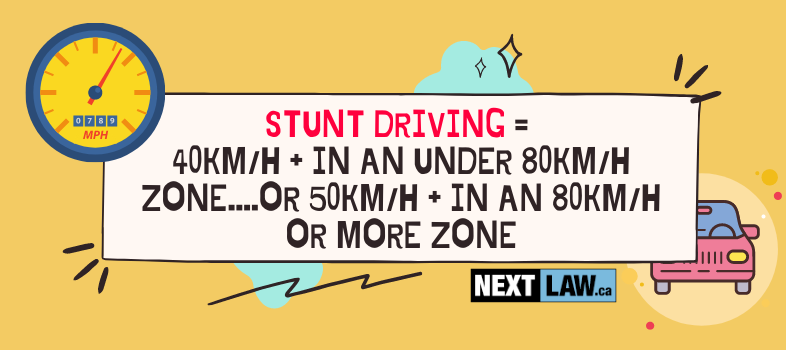
| Posted Speed Limit | Stunt Driving Threshold | Example |
|---|---|---|
| Under 80 km/h | 40+ km/h over limit | 90+ km/h in 50 km/h zone |
| 80+ km/h | 50+ km/h over limit | 130+ km/h in 80 km/h zone |
| Any Zone | 150+ km/h | 150 km/h in 110 km/h zone |
Stunt driving refers to speeds exceeding 40km/hour over the posted limit in zones under 80km/hour and speeds exceeding 50km/hour over the posted limit in zones of 80km/hour or more.
In Ontario, if you receive a ticket for driving at such speeds above the stipulated limit, it isn’t merely a speeding ticket. The charge is officially classified as “Stunt Driving” under Ontario law.
The specifics of Stunt Driving or Racing are detailed under section 172 of Ontario’s Highway Traffic Act. For a comprehensive understanding of the charges, refer to the exact language of the act here.
If you’ve been charged with Stunt Driving or Racing in Ontario, it’s crucial to understand that you’ll be required to attend court. The police, upon charging you with stunt driving, would have issued a summons, outlining the necessary details for your court appearance.
Receiving a stunt driving summons in Ontario mandates a court appearance. It details your court date and may offer remote attendance options. Understanding this process is crucial for legal compliance.
This summons might appear similar to a standard traffic ticket, but it is actually a summons that mandates your appearance in court.
The summons for your Stunt Driving or Racing charge will clearly specify the date, time, and location of the court where you’re expected to appear. In light of the digital era, you might have the option to attend the court proceedings remotely via Zoom. Alternatively, in-person court dates might also be available.
Look to the summons for all the necessary information on how to virtually attend your court date or where to attend in person. Understanding the court process for stunt driving charges is an essential step in navigating this situation effectively.

Immediate roadside: 14-day vehicle impound • 30-day licence suspension.
On conviction: $2 000–$10 000 fine • six demerit points • one- to three-year licence loss • up to six months’ jail • mandatory Driver Improvement Course. Repeat offences double the suspension and push fines toward $10 000.
Here is a more detailed breakdown of the penalties:
| Penalty Type | First Offense | Repeat Offense | When Applied |
|---|---|---|---|
| Immediate Suspension | 30 days | 30 days | Roadside (immediate) |
| Vehicle Impound | 14 days | 14 days | Roadside (immediate) |
| Court Fines | $2,000 – $10,000 | $5,000 – $25,000 | Upon conviction |
| License Suspension | 1-3 years | 2-10 years | Upon conviction |
| Jail Time | Up to 6 months | Up to 2 years | Upon conviction |
| Demerit Points | 6 points | 6 points | Upon conviction |
| Driver Improvement Course | Mandatory | Mandatory | Required for license reinstatement |
It’s crucial to remember that these penalties can change and may differ based on the specifics of the incident. Repeat offenders should anticipate more severe consequences, such as longer license suspensions and increased fines. The penalties for Stunt Driving or Racing are found in section 172 of the Highway Traffic Act of Ontario. For personalized advice regarding your situation, it’s recommended to consult with a legal professional.

Stunt driving penalties in Ontario are stringent due to the public safety risks. These offences, treated more seriously than regular traffic violations, aim to deter dangerous driving behaviours.
Stunt driving penalties in Ontario depend on factors like speed, driving history, incident location, and police interactions. These contribute to the severity of the imposed penalties.. Some of these factors include:
Unlike fixed penalties for simple speeding, stunt driving penalties in Ontario vary, reflecting the offense’s severity. This flexible penalty system addresses the seriousness of each individual case.
The penalties for Stunt Driving or Racing in Ontario are purposely defined by the lawmakers as a range. In other words, the penalties are not fixed.
This is very different than the penalties for simple speeding under section 128 of the Highway Traffic Act. With simple speeding, the fines and demerit point penalties are fixed. There is no discretion with what your penalty is going to be.
However, if you are charged with Stunt Driving or Racing in Ontario, the penalties that you are subject to have a very wide range. These penalties are NOT fixed because of the severity of the Stunt Driving or Racing charge. The more severe your case is, the more severe the penalty will be.
G2 drivers in Ontario face strict penalties for stunt driving, including additional license suspensions. Understanding these unique penalties is crucial for G2 license holders.
If a G2 driver accumulates more than three demerit points at any time, they face a 30-day license suspension even after your Stunt Driving case.
Let’s illustrate this with an example: If your speed was recorded lower than stunt speed – say, 39km/hour, a conviction would result in an additional 30-day suspension.
This disciplinary action is unrelated to court decisions. Instead, it is the Ministry of Transportation Ontario (MTO) that implements these penalties. The MTO has a stringent policy of an automatic 30-day suspension for any G2 license holder who amasses more than three demerit points. Therefore, adhering to traffic regulations is vital to maintain your driving privileges.
In Ontario, stunt driving is not a criminal charge but a serious offense under the Highway Traffic Act. Convictions do not result in a criminal record but carry significant penalties.
The Criminal Code of Canada does have charges that are focused on driving such as Dangerous Driving. So, if the Stunt Driving or Racing event is so severe, the Police may decide to pursue charges against you under the Criminal Code of Canada.
Stunt driving in Ontario is distinct from regular speeding tickets, with more severe consequences including vehicle impoundment, license suspension, and a rigorous legal process.
It’s essential to understand the key distinctions between a regular speeding ticket, governed by Section 128 of the Highway Traffic Act, and the more severe penalties associated with Stunt Driving or Racing, outlined in Section 172 of the same Act. The differences are marked and can significantly impact your daily life and driving record.
Immediate Impoundment of Your Vehicle: If you are charged with Stunt Driving or Racing, your vehicle is immediately towed and impounded for a two-week period (14-days) as of the updated regulation from June 3, 2021. All associated expenses from this process fall on your shoulders.
Mandatory Driver’s License Suspension: An immediate 30-day suspension of your driver’s license is enforced (according to the updated MOMS Act, June 3, 2021). This means you cannot operate any vehicle, even if you own more than one. What’s more, this 30-day suspension remains on your driver’s record, irrespective of the final verdict on your Stunt Driving or Racing charge.
The Legal Process is More Severe: A Stunt Driving or Racing charge carries with it a more intensive legal process than a speeding ticket. Instead of settling your case through mail or online, you’ll be subjected to a quasi-criminal process. This means you’re legally required to attend court, review the evidence presented against you, and potentially engage in multiple court dates that can span up to 18 months.
Higher Penalties if Convicted: The penalties are stark if you are convicted of Stunt Driving or Racing. These can range from hefty fines, demerit points, and license suspension to probation, and in more extreme cases, incarceration.
Read above, Chapter 2, for more details on the penalties. Understanding these key differences emphasizes the seriousness of Stunt Driving or Racing charges, highlighting the importance of obeying traffic rules for both your safety and the safety of others on the road.
Insurers flag stunt-driving convictions as “high-risk”—expect 3- to 5-times premiums or flat refusals. Because the charge stays on your MTO abstract for three full years, the cost spike mirrors that timeline.
If you get caught stunt driving or racing in Ontario, your car insurance costs can go up significantly because insurance companies will see you as a “high-risk” driver. If you’re convicted, you can lose your driving license for 1 to 3 years. During this time, you don’t need to worry about insurance because you can’t drive or have an insurance policy. But after the suspension, it can be hard to get car insurance. You might have to pay substantially more, or you might not be able to get insurance at all for a few years because stunt driving is such a serious offence under the Highway Traffic Act.
Yes, insurance companies unquestionably assess your risk profile by analyzing your driving history. As such, any charge or conviction associated with Stunt Driving or Racing can influence your risk perception significantly. This, in turn, directly affects your car insurance rates.
Indeed, in Ontario, a conviction for Stunt Driving or Racing categorizes you as a ‘high-risk’ driver. This designation could potentially lead an insurer to consider you as an overly risky client, consequently resulting in a denial of car insurance coverage.
In Ontario, a Stunt Driving or Racing conviction remains on your driving record for three years. Therefore, this charge could impact your car insurance premiums for the same duration.
Understanding these potential consequences highlights the importance of practicing safe driving habits. By doing so, you can maintain affordable insurance rates and guarantee continuous coverage. Always bear in mind that responsible driving not only safeguards you but also your passengers and fellow road users.
Navigating a stunt driving or racing charge in court is a complex process. The path to getting these charges dropped is often through a major flaw in the evidence or “disclosure,” an 11b Charter argument asserting a trial within a reasonable timeframe, or the prosecutor’s discretion based on the “interests of justice” or “public interest.”
Minor errors in the disclosure, such as misspellings or incorrect details like the license number or date of the offence, can often be rectified and don’t usually result in charge withdrawal. But, a major error discovered by a seasoned law firm can lead to charge dismissal.
The 11b Charter argument is not straightforward, though. It’s crucial to remember that delays for this argument should be instigated by the Province, not you. COVID has complicated this aspect as court delays occurred due to “Emergency Act” measures. Implementing this argument requires a thorough history of your court interactions and may necessitate legal assistance.
The notion of “interests of justice” or “public interest” is entirely at the prosecutor’s discretion. The province only needs to prove the accuracy of the radar or laser device for your charge to stand. Hence, finding a compelling major error or reason could lead to charge withdrawal, and it’s highly recommended to employ professional legal aid for this. Remember, only the prosecutor has the authority to proceed with the charges.
Is there a significant mistake in your stunt driving or racing ticket? If so, it might be possible to have the charge withdrawn.
Let’s explore the two types of errors that can occur with your charge: Fatal Errors and Minor Errors.
Understanding the implications of a “Fatal Error”:
What happens if there’s a “Minor Error” in your charge?
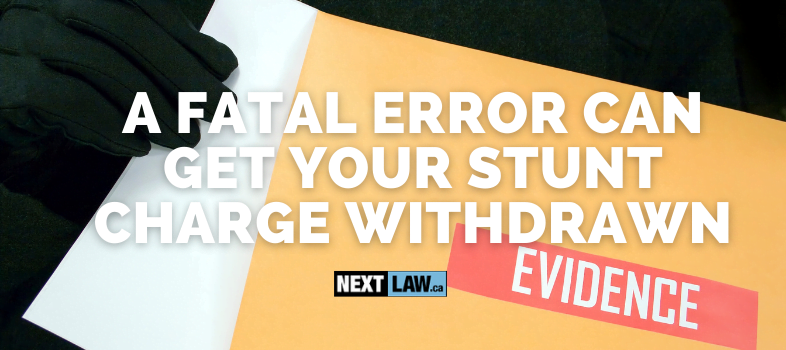
What is your primary source for spotting disclosure errors in stunt driving charges? Your answer should be: the disclosure document. This comprehensive document contains all the evidence that the court will use against you in your stunt driving case.
Do you suspect missing evidence? If you’re of the opinion that essential evidence or information hasn’t been included in your disclosure, it’s crucial that you ask for the missing information to be provided. Engage with the Prosecutor to understand the steps to take in requesting the missing disclosure.
How does the Prosecutor react to a Fatal Error? When confronted with a Fatal Error in the disclosure, the Prosecutor might choose to withdraw the stunt driving charge against you.
Can the Justice of the Peace dismiss the charge? Absolutely. If the Justice of the Peace identifies a Fatal Error, they have the authority to rule that the stunt driving charge be dismissed or dropped altogether.
There are valid defences to fight an Ontario Stunt Driving or Racing charge.
However, most “excuses” are NOT defences. Because a Stunt Driving or a Racing charge is a public safety offence, the lawmakers made it very difficult to “win” these cases. That means most excuses won’t get you off this charge.
No, this is NOT a defence.
No, this is NOT a defence.
No, this is NOT a defence.
See logic above.
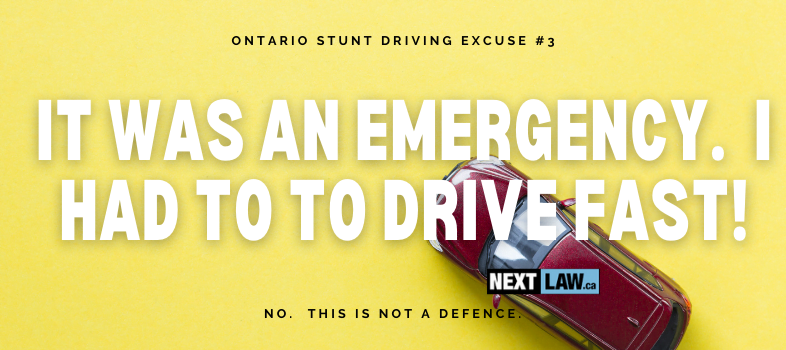
No, this is NOT a defence.
The fact that no one was hurt has no legal meaning. See logic above.
No, this is NOT a defence.
Yes, the penalties are severe because the lawmakers want “responsible” drivers on the road. And for those people that do not drive responsibly, the law will punish them appropriately.
In a stunt driving or racing case, understanding the roles of the three main players is crucial:
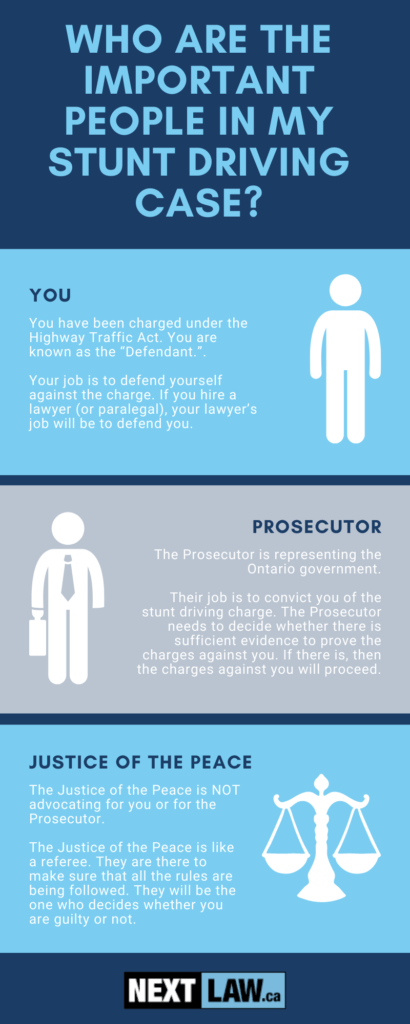
In an Ontario stunt driving or racing case, three main individuals each play critical roles:
The prosecutor has a lot of power in your Ontario Stunt Driving case.
As you read above, the Prosecutor is not your friend.
The Prosecutor’s job is to convict you of the Stunt Driving or Racing charge against you.
The Prosecutor needs to make 2 decisions.
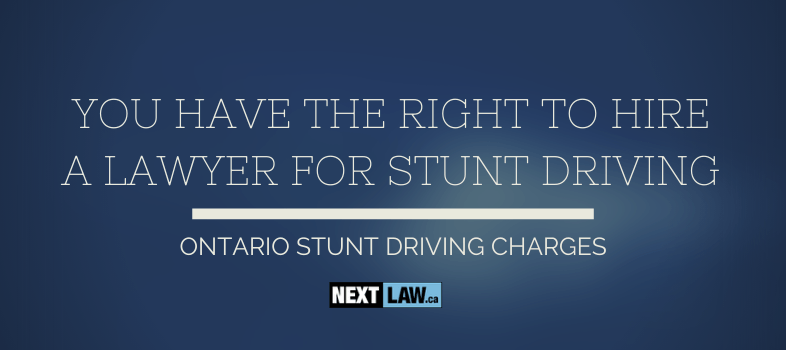
Ontario traffic courts aim to finish stunt-driving cases within 18 months (the Jordan ceiling). Real-world 2025 data show an average of 9–12 months from first appearance to resolution.
Typically, the Ontario court system endeavors to bring charges to trial within an 18-month window from the date of the charges. This duration is reflective of the time required to comprehensively prepare and present a case, balancing both the needs of the prosecution and the defendant.
If your case extends beyond this 18-month guideline, it may potentially infringe upon your constitutional right to a trial within a reasonable time. This could pave the way for the dismissal of your charges, based on the argument that your rights have been violated.
Keep in mind, this is a constitutional argument that necessitates a deep understanding of legal principles and precedents. Therefore, it’s highly recommended that you consult your lawyer if your case crosses the 18-month threshold, to strategize and ascertain the possibility of having your charges withdrawn.
Remember, the legal process for a Stunt Driving charge in Ontario is methodical and aims at ensuring justice. Patience, preparation, and professional advice from your lawyer will be crucial in navigating this journey successfully.
Are you facing a Stunt Driving charge in Ontario and feeling overwhelmed by the legal process? In this guide, we demystify the stages of court appearances you’ll encounter, making your journey through the legal system less daunting.
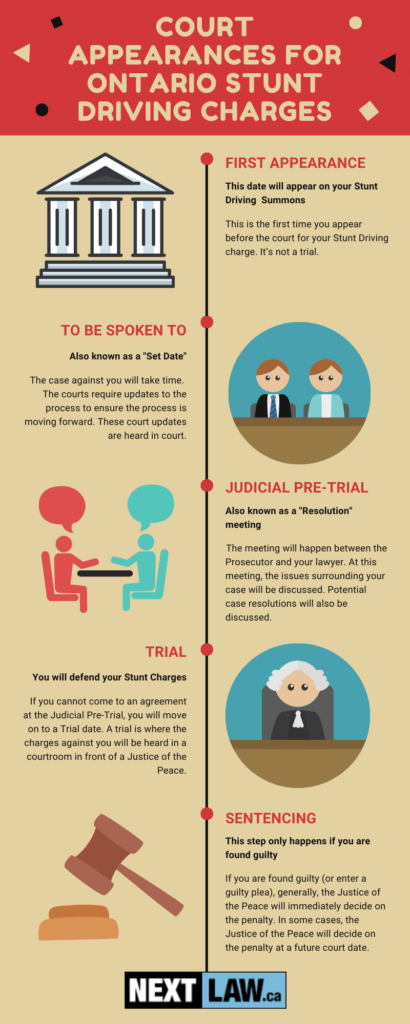
This guide aims to simplify your understanding of the Ontario Stunt Driving court process, allowing you to approach each court appearance with knowledge and confidence.
The first appearance is not a trial; it sets disclosure deadlines, lets you request early resolution, and—if you retain counsel—can be attended by your lawyer via Zoom or phone.
When you were charged with Stunt Driving or Racing in Ontario, the police officer gave you a summons with your court details for your first appearance. The details will include the date, time and the court where you need to appear.
Many court dates are a hybrid of Zoom, phone or in person. If you choose to attend remotely, the court will inform you on how to login via Zoom for your court date.
Barrie, Belleville, Bracebridge – Muskoka, Brampton, Brockville, Caledon, Cayuga – Haldimand,Chatham – Kent, Cobourg, Cochrane, Cornwall, Dundas & Glengarry, Durham, Dryden, Elliot Lake, Espanola, Fort Frances, Goderich – Huron, Gore Bay, Guelph, Haileybury, Burlington, Hamilton, Kenora, Kingston, Kitchener / Waterloo, Lindsay – Kawartha Lakes, London, Mississauga, Napanee, Newmarket, North Bay, Orangeville, Orillia, Ottawa, Owen Sound, Parry Sound, Pembroke – Renfrew, Perth, Peterborough, Picton – Prince Edward County, Sarnia, Sault Ste. Marie, Simcoe – Norfolk, St. Catharines – Niagara Region, Stratford – Perth, Sudbury, Thunder Bay, Timmins, Toronto East, Toronto South, Toronto West, Welland – Niagara Region, Windsor, Woodstock – Oxford.
You can find a complete address list of Provincial Offences courts here
Here’s what’s going to happen at court appearance for your Stunt Driving or Racing charge.
Meet the Prosecutor and get your evidence – You are going to meet with the Prosecutor. And, that Prosecutor is going to give you the evidence, which will be put into your Disclosure.
Your meeting with the Prosecutor may be very brief because you are simply checking in to let the court know that you are there. In some cases, there may be time to speak with the Prosecutor about your case. Whether there is time (or not) to speak about your case is the decision of the Prosecutor.
After meeting with the Prosecutor, you have 3 options to consider for the next steps.
There is NO downside to ask for this delay. It’s important to understand the charge you are facing, the evidence the court has against you and the penalties that you face. Take the time to make an informed decision.
Lastly, a new court date will be set. Assuming you did not enter a guilty plea, you will appear before the Justice of the Peace and a new court date will be set.
Practically, they are the same thing.
Evidence are the facts upon which the prosecution will use to try to prove the Stunt Driving or Racing charges against you.
Disclosure is the “package” of evidence that will be given to you at your first appearance.
Disclosure typically includes a synopsis of the police summary of the case against you, the police officer’s notes, witness statements and a screening form (which an offer for resolution).
Yes.
You legally have the right to get all the evidence that the court has against you.
Getting all your evidence is NOT a choice of the prosecutor or the court. The court must give you all the evidence. If you do not get all the evidence, it may be possible to get the charges against you withdrawn.
Maybe.
Occasionally, the evidence against you may not be ready by the time you arrive at your first appearance.
In this case the court will set another court date to give the court and the prosecutor more time to get the evidence.
However, if after a few court dates you still don’t have your disclosure, the Justice of the Peace may dismiss the charges against you.
Not necessarily. And this is a very important point to know.
Even when you get your disclosure, that does not mean that you have all the evidence against you. In fact, your disclosure package may be missing some key evidence.
If you suspect there is missing evidence, you can ask the court and the prosecutor, for that additional evidence.
Getting ALL your evidence is critical for you to be able to make an informed decision on how you want to proceed with your case.
No.
The Police Officer is not required to be at your First Appearance. If your case goes to trial, then yes, the Police Officer that charged you will be called upon to give the evidence that he or she has against you.
No. Your “First Appearance” is not a trial. It’s the first time you appear before the court for your Stunt Driving or Racing charge.
If you decide to go to trial, then your trial date will be set at some point in the future. That date may be days, weeks, or many months in the future. But your trial will NOT happen on your first appearance.
If you have hired a lawyer, then no. You do not need to attend your First Appearance because your lawyer will attend on your behalf.
If you have not hired a lawyer, then yes. You will need to attend your First Appearance.
Maybe. For the first appearance, you may be able to have someone attend on your behalf. However, you should give that person written permission that they are allowed to attend on your behalf and include the reason why you are not able to attend.
Immediate: 14-day vehicle impound and 30-day roadside licence suspension. On conviction: $2,000–$10,000 fine, six demerit points, up to six months’ jail, and a mandatory one- to three-year licence suspension.
Call ServiceOntario about three to five days before the suspension ends (1-800-387-3445) and book a reinstatement appointment. Bring your impound/suspension paperwork. The reinstatement fee is $0, but any unpaid fines must be cleared.
Towing and storage fees vary by region—budget $900–$1,500+. Phone the impound yard early to confirm daily storage rates, required ID, and pickup hours so you can collect the vehicle on day 15 without surprises.
A withdrawal is possible when disclosure reveals fatal errors—missing radar logs, improper stop, Charter breaches. An experienced lawyer can leverage these defects to negotiate withdrawal or argue a Charter motion in court.
No. Stunt driving is prosecuted under the Highway Traffic Act, not the Criminal Code, so a conviction appears on your driving record—never on a criminal record.
You deserve better.

Stunt Driving Ontario: Complete 2026 Legal Guide Stunt driving charges in Ontario have reached unprecedented levels in 2025, with legal representative Jon Cohen documenting a
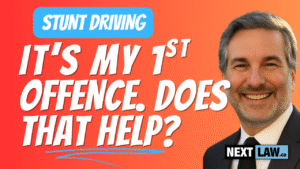
When charged with stunt driving under Section 172(1) of Ontario’s Highway Traffic Act, defendants with clean driving records desperately hope their first-offence status will generate
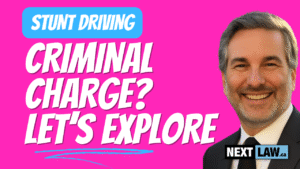
Is Stunt Driving a Criminal Offence in Ontario? No, stunt driving is not a criminal offence in Ontario. Stunt driving charges fall under Section 172

Why “We Win or It’s Free” Guarantees for Stunt Driving Cases Are Illegal and Unethical When desperately searching for a stunt driving lawyer after being
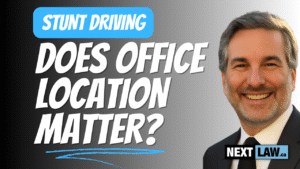
Why Office Location is Irrelevant When Choosing Ontario’s Best Stunt Driving Lawyer When facing stunt driving charges under Section 172(1) of Ontario’s Highway Traffic Act,

Hiring for Stunt Driving Defence: Critical Red Flags That Could Cost You Your License If you’re facing stunt driving charges in Ontario, choosing the right